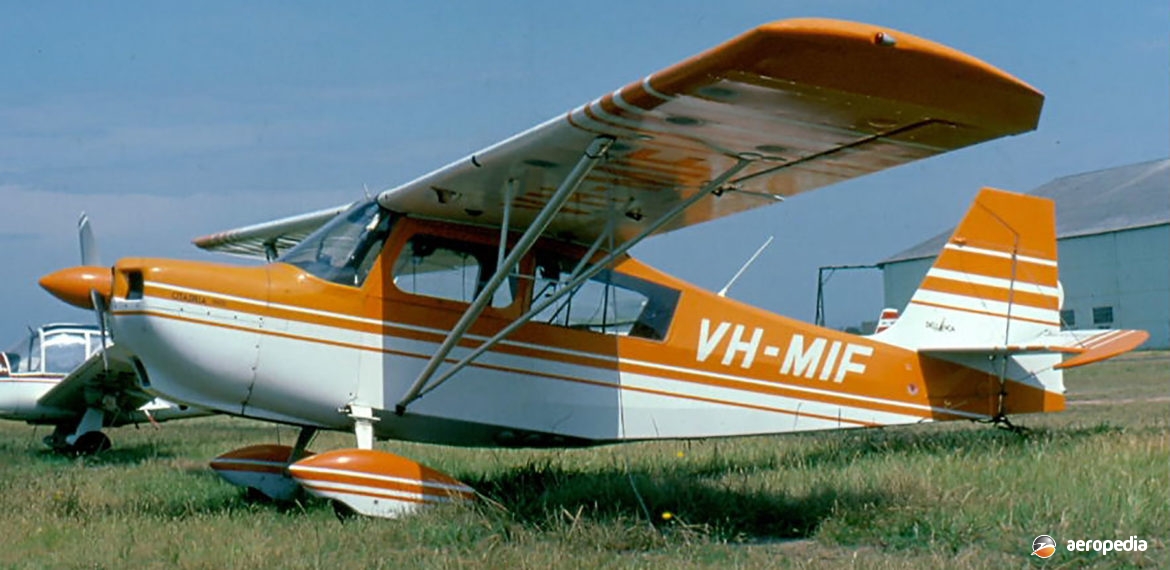Photograph:
Bellanca 7GCBC Citabria VH-MIF (c/n 1012-78) at Bankstown, NSW in November 1982 (David C Eyre)
Country of origin:
United States of America
Description:
Two-seat light cabin monoplane
Power Plant:
One 119 kw (160 hp) Lycoming O-320-B2B four-cylinder horizontally-opposed air-cooled engine
Specifications:
- Wingspan: 10.49 m (34 ft 5 in)
- Length: 6.92 m (22 ft 8½ in)
- Height: 2.35 m (7 ft 8½ in)
- Wing area: 15.79 m² (170 sq ft)
- Max speed at sea level: 217 km/h (135 mph)
- Cruising speed at 75% power: 211 km/h (131 mph)
- Cruising speed at 65% power: 198 km/h (123 mph)
- Stalling speed flaps down: 71 km/h (44 mph)
- Initial rate of climb: 410 m/min (1,345 ft/min)
- Take-off run: 93 m (305 ft)
- Landing run: 95 m (310 ft)
- Service ceiling: 5,181 m (17,000 ft)
- Range at 75% power: 799 km (496 miles)
- Range at 55% power: 966 km (600 miles)
- Empty weight: 544 kg (1,200 lb)
- Loaded weight: 816 kg (1,800 lb)
History:
The Champion 7ECA Citabria was a modernised version of the Champion 7EC Traveller and was first produced by the Champion Aircraft Corporation. The prototype was flown for the first time in May 1964. Production began in August of that year and the two-seater was powered by an 81 kw (108 hp) Continental engine.
Subsequently, the Bellanca Aircraft Corporation took over production as the 7ECA Citabria and fitted the type, at first, with an 86 kw (115 hp) Lycoming engine. The wing, fuselage and undercarriage were similar to the previous models, with the major changes being larger cabin windows, a re-designed squarish vertical tail, and wheel spats.
A number of models in the series was built, including 7GCAA, 7KCAB, and 7GCBC, all being similar to the 7ECA but had the 112 kw (150 hp) Lycoming O-320 engine. In addition, the 7KCAB had modified fuel and oil systems to permit inverted flying, and the 7GCBC was fitted with flaps.
The Citabria was the first aircraft certificated for limited aerobatics by the Federal Aviation Aeronautic (FAA). More than 25 examples have been registered in this region. One for a period operated from Pittwater, NSW on floats. In 1990 American Champion Aircraft Corporation of Rochester, Wisconsin put the model back into production, the type having been previously built by Bellanca Aircraft Corporation and Champion Aircraft Corporation, the Citabria being built in three models known as the Model 7ECA Citabria Aurora, 7GCAA Citabria Adventure and the 7GCBC Citabria Explorer.
The 7ECA Citabria Aurora was the lowest powered of the range and was first introduced in the 1950s, 1,352 examples being delivered by Aeronca before production was taken over by Champion Aircraft in 1964. New models had improved ventilation and heating, a re-designed instrument panel, a quick-jettison door and dual controls, being fitted with an 88 kw (118 hp) Textron Lycoming O-235-K2C four-cylinder engine driving a Sensenich fixed-pitch propeller.
The 7GCAA Citabria Adventure was the original Aeronca Model 7 and with some up-grading became the 7GCAA in 1997. It was a high-wing monoplane with a quick-jettison door with normal conventional controls and no flaps. It was of steel tube construction with fabric covering. It had a 119 kw (160 hp) Textron Lycoming O-320-B2B four-cylinder engine driving a two-blade fixed-pitch Sensenich propeller. The cockpit seated two in tandem with dual controls.
The 7GCBC Citabria Explorer was a two-seat model suitable for training which received certification in 1993. The fuselage was of welded steel tube with wire bracing and fabric covering. The wing had two aluminium spars. The engine was the 119 kw (160 hp) Textron Lycoming O-320-B2B unit.

